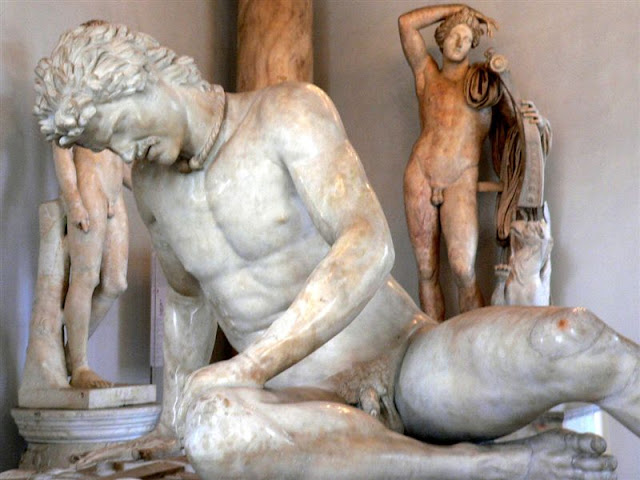In 1 BCE, the Roman poet Pūblius Ovidius Nāsō , known to us as Ovid, penned three books, the Ars amatoria (The Art of Love) instructing Romans in the techniques of seduction and love. The first book addresses men and teaches them how to seduce women, the second, also to men, teaches how to keep a lover. The third book addresses women and teaches seduction techniques. Ovid describes the places one can go to find a lover, like the theater, a triumph, which he thoroughly describes, or arena – and ways to get the girl to take notice, including seducing her covertly at a banquet. Ovid emphasizes care of the body for the lover and advises men to avoid giving too many gifts, keep up their appearance, hide affairs, compliment their lovers, and ingratiate themselves with slaves to stay on their lover's good side. Ovid gives women detailed instructions on appearance telling them to avoid too many adornments. He advises women to read elegiac poetry, learn to play games, sleep with people of different ages, flirt, and dissemble. Book three ends with his wish that women will follow his advice and spread his fame saying Naso magister erat, "Ovid was our teacher". (Ovid was known as "Naso" to his contemporaries.)
Unfortunately for Ovid, the Emperor Augustus, who had enacted his Julian marriage laws which promoted monogamous marriage to increase the population's birth rate in 18 BCE, did not take kindly to Ovid's disregard for what Augustus viewed publicly as the serious crime of adultery. (According to Suetonius, Augustus himself was "given to adultery not even his friends deny, although it is true that they excuse it as committed not from passion but from policy, the more readily to get track of his adversaries' designs through the women of their households." Even the boisterous Marc Antony charged him with taking the wife of an ex-consul from her husband's dining room before his very eyes into a bed-chamber, and bringing her back to the table with her hair in disorder and her ears glowing.)
Although Augustus did not act immediately, after his daughter Julia's very public lascivious rebellion against her father's moral restrictions and possible implication in her husband's conspiracy against Augustus which Ovid may have known about, the poet was exiled to the island of Tomis by the Black Sea where he died in 17 or 18 CE. The order was issued by Augustus alone, without any participation of the Senate or of any Roman judge. Ovid himself wrote many references to his offense, but gave only obscure or contradictory clues.
Ovid wrote two poetry collections while in exile, Tristia and Epistulae ex Ponto, which illustrated his sadness and desolation. Being far from Rome, he had no access to libraries, and thus might have been forced to abandon his Fasti, a poem about the Roman calendar, of which only the first six books exist. The Tristia expresses the poet's despair in exile and advocates his return. The Epistulae ex Ponto was a series of letters to friends pleading with them to effect his return. But at one point his anger at what he viewed as his unjust punishment boiled over and he penned the Ibis, a curse poem attacking a powerful but unnamed adversary in Rome, modeling the work on a lost poem of the same title by the Greek Alexandrian poet Callimachus. Candidates for "Ibis" have been suggested including Hyginus, Cassius Severus, Titus Labienus, Thrasyllus of Mendes, Caninius Rebilus, Ovid's erstwhile friend Sabinus, and the emperor Augustus, but scholars cannot agree if "Ibis" refers to a single person, to more than one person, or to nobody at all. Ovid threatens his enemy in the second section of the poem (lines 251–638) with a veritable catalogue of "gruesome and mutually incompatible fates" that befell various figures from myth and history, ranging from laming and blinding to cannibalism to death by pine cone. (I tried to find out what "death by pine cone was, particularly since I live in the Pacific Northwest where coniferous trees are abundant, but had no luck!) Ovid also declares that even if he dies in exile, his ghost will rise and rend Ibis' flesh.
Image: Hollow cast bronze Ibis eating a lizard, Roman, 100 BCE - 100 CE, now in the collections of the Cleveland Museum of Art, image courtesy of the museum. When I saw this beautiful sculpture I wondered if it could have been a symbol of resistance against Roman imperial rule in a well-read Roman household.

























































